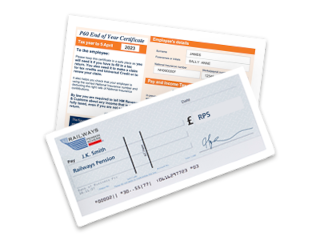My pension payments and P60s
Find out how you'll receive your pension and get information about your P60.

Your pension is reviewed every year and increases in line with orders published by the government. You can find out more and see this year's increase on the annual pension increase page.
Any tax you owe is taken from your pension before it reaches your bank account. The amount of tax you pay is based on your tax code. You can see your current tax code on your P60 (see below). You tax code is given to you by HM Revenue & Customs (HMRC). If you have any questions about it, you should speak to your local tax office. You can find more information at gov.uk/tax-codes.
The amount of tax you pay may also be affected if you are still working or return to work while taking your pension. You can read more on the working after taking my pension page.
You can find more information about all of this in the Read as You Need guide to your pension payments.
For details on what happens to your pension payments when you die, visit the my pension when I die page.
You can see the dates for this year's pension payments on the pension payment calendar.
A copy of the pension payment calendar will also be sent to you with your Autumn issue of Penfriend.

It’s important you tell us as soon as possible if you change your bank or building society. That way, you can continue to get your pension payments without any delays. You can log in to your myRPS account to update your details or find more information on the updating my bank details page.
You get a P60 form in April, at the end of every tax year. It confirms your final tax code for the year and has details of:
You should keep your P60 for at least two years in case you need to complete a tax return. It may help with other paperwork too.
You can find a copy of your P60 when you log in to your myRPS account.
Find out the rates for this year's pension increase and what it's based on.
Have you changed your bank or building society? Let us know so we can make sure your pension is still paid.
Read the latest Penfriend newsletter, packed full of useful information about your pension and stories from rail industry colleagues.